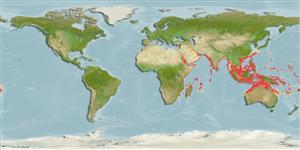Common names from other countries
>
Eupercaria/misc (Various families in series Eupercaria) >
Caesionidae (Fusiliers) > Gymnocaesioninae
Etymology: Gymnocaesio: Greek, gymnos = naked + Latin, caesius, bluish-grey, 1835; it is the same name given to the silvery metal (Cs) (Ref. 45335).
More on author: Bleeker.
Environment: milieu / climate zone / depth range / distribution range
Ecologia
marinhas associadas(os) a recifes; não migratória; intervalo de profundidade 0 - 500 m (Ref. 402). Tropical; 31°N - 30°S, 32°E - 177°W (Ref. 402)
Indo-West Pacific: Red Sea and East Africa to Fiji, north to the Philippines.
Tamanho / Peso / Idade
Maturity: Lm ? range ? - ? cm
Max length : 18.0 cm TL macho/indeterminado; (Ref. 402)
Espinhos dorsais (total) : 10 - 11; Raios dorsais (total) : 14 - 16; Espinhos anais: 3; Raios anais : 11 - 13.
Inhabits coastal areas around coral reefs (Ref. 30573). Feeds on zooplankton in large midwater aggregations. Forms schools with members of the genus Pterocaesio. Oviparous, with numerous, small pelagic eggs (Ref. 402). Often mistaken for juveniles and easily overlooked because of small size (Ref. 48636). Also caught with drive-in nets. Utilized as tuna bait fish (Ref. 30573).
Ciclo de vida ou comportamento de acasalamento
Maturities | Reprodução | Spawnings | Egg(s) | Fecundities | Larvas
Carpenter, K.E., 1987. Revision of the Indo-Pacific fish family Caesionidae (Lutjanoidea), with descriptions of five new species. Indo-Pac. Fish. (15):56 p. (Ref. 1723)
Status na Lista Vermelha da UICN (Ref. 130435)
CITES (Ref. 128078)
Not Evaluated
Ameaça para os humanos
Harmless
Uso pelos humanos
Pescarias: pouco comercial; isca: usually
Ferramentas
Relatórios especiais
Baixar XML
Fontes da internet
Estimates based on models
Preferred temperature (Ref.
115969): 15 - 27.8, mean 23.6 (based on 824 cells).
Índice de diversidade filogenética (Ref.
82804): PD
50 = 1.0000 [Uniqueness, from 0.5 = low to 2.0 = high].
Bayesian length-weight: a=0.01122 (0.00514 - 0.02450), b=3.04 (2.87 - 3.21), in cm Total Length, based on all LWR estimates for this body shape (Ref.
93245).
Nível Trófico (Ref.
69278): 3.4 ±0.45 se; based on food items.
Resiliência (Ref.
120179): Elevada, tempo mínimo de duplicação da população menor que 15 meses (Preliminary K or Fecundity.).
Fishing Vulnerability (Ref.
59153): Low vulnerability (10 of 100).
